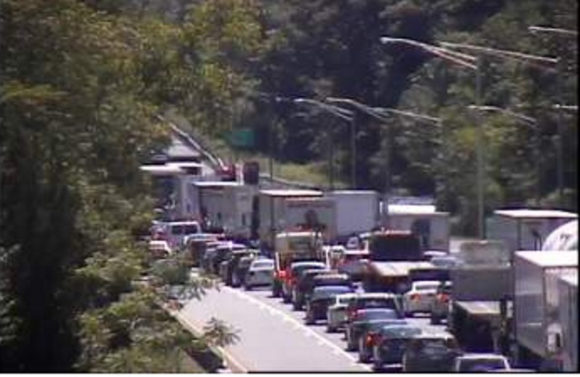
Our air stinks. In fact, Fairfield County ranks in the top 25 of most polluted areas in the US, mostly due to ozone levels.
And while much of those noxious gases drift our way from New Jersey and New York City, a large part of our pollution is home-grown: it’s due to heavy volumes of traffic, especially diesel trucks, which emit nitrogen oxides (NOx) and volatile organic compounds (VOCs)—key ingredients in ozone formation.
Yes: I-95 is hazardous to your health.
And all of this gets worse in the summer due to the heat which increases ozone production, often trapping it over our heads due to temperature inversions. By one estimate, almost 200 Connecticut residents die each year due to our air quality.
We will all remember back to June of 2023 when our sky turned orange due to smoke from Canadian wildfires. That created truly hazardous conditions that literally made breathing bad for you. With global warming, we’ll see things like this happening again.
So, what does any of this have to do with transportation? Mother nature’s pains (like the Canadian wildfires) notwithstanding, it is transportation’s pollution that is the #1 source in our state, EPA blaming it for half of all our bad air.

Trucks:
These are the vehicles responsible for most of our air pollution. While medium to large trucks represent only 6% of traffic they cause 53% of nitrogen oxide (NOx) emissions, 45% of fine particulate matter (PM2.5), linked to respiratory and cardiovascular health issues, and 25% of greenhouse gas emissions.
Better air filters may help as does burning biodiesel and enforcing no-idling rules. But the real solution will be electric-powered trucks. However, the Trump administration has slashed tax credits for new buyers and frozen plans for the rollout of charging stations.
Take the Train:
Riding Metro-North is five to six times more fuel efficient than driving. Those electric trains’ power-generation gives them the equivalent of 125-160 mpg. And that’s improved further by the trains’ regenerative braking which means that, even when stopping, they generate more power.
Getting more folks on the train also reduces highway traffic, making those vehicles more fuel efficient because they’re not spewing exhaust in stop-and-go traffic.
But our diesel locomotives (which run on the Danbury, Waterbury and Hartford lines) are a different matter. For their runs in Connecticut they are big polluters, just like trucks. The World Health Organization and EPA call diesel exhaust a Class 1 carcinogen, right up there with tobacco and asbestos. New locomotives that are on order will improve that with battery operation and improved filtration.
Ships:
Yes, both commercial and pleasure craft contribute to air (and in this case noise and water) pollution, again because of their diesel engines. It’s not by chance that wind-powered sailors refer to powerboaters as “stink potters” and “blow boaters”. There are some electric-powered boats under development, but they’re more expensive and don’t offer the same range.
So, whether your travels take you on the open waters or (hopefully) open roads, remember that there’s more to the cost of your trip than fuel: there’s the cost to our shared environment.
Editor’s Notes: i) Jim Cameron is the founder of the Commuter Action Group and advocates for Connecticut rail riders. He writes a weekly column called ‘Talking Transportation,’ which is published by a number of publications in the state.
ii)”Talking Transportation” recently won first place in the general column/commentary category in the Connecticut Society of Professional Journalists Excellence in Journalism Contest.